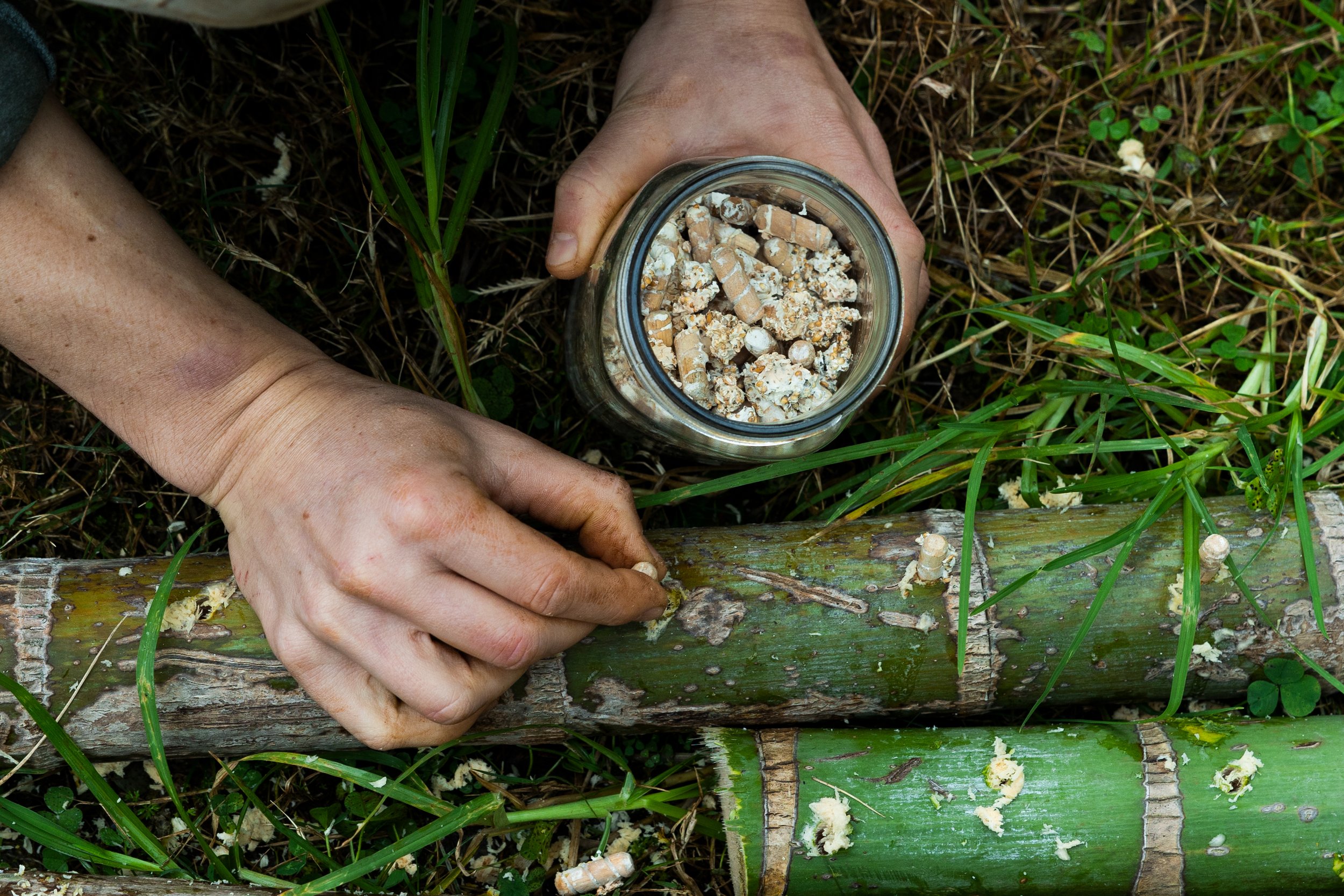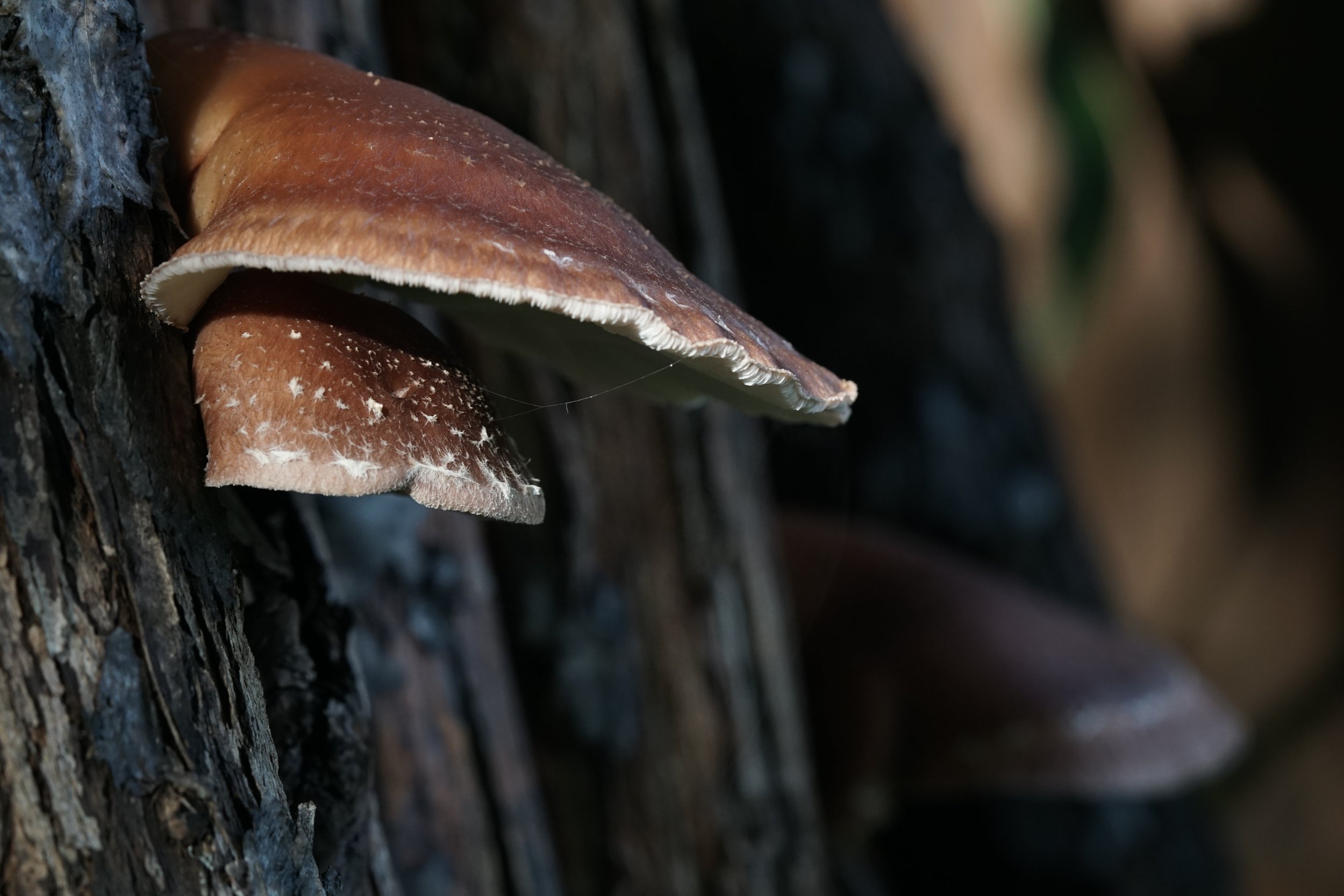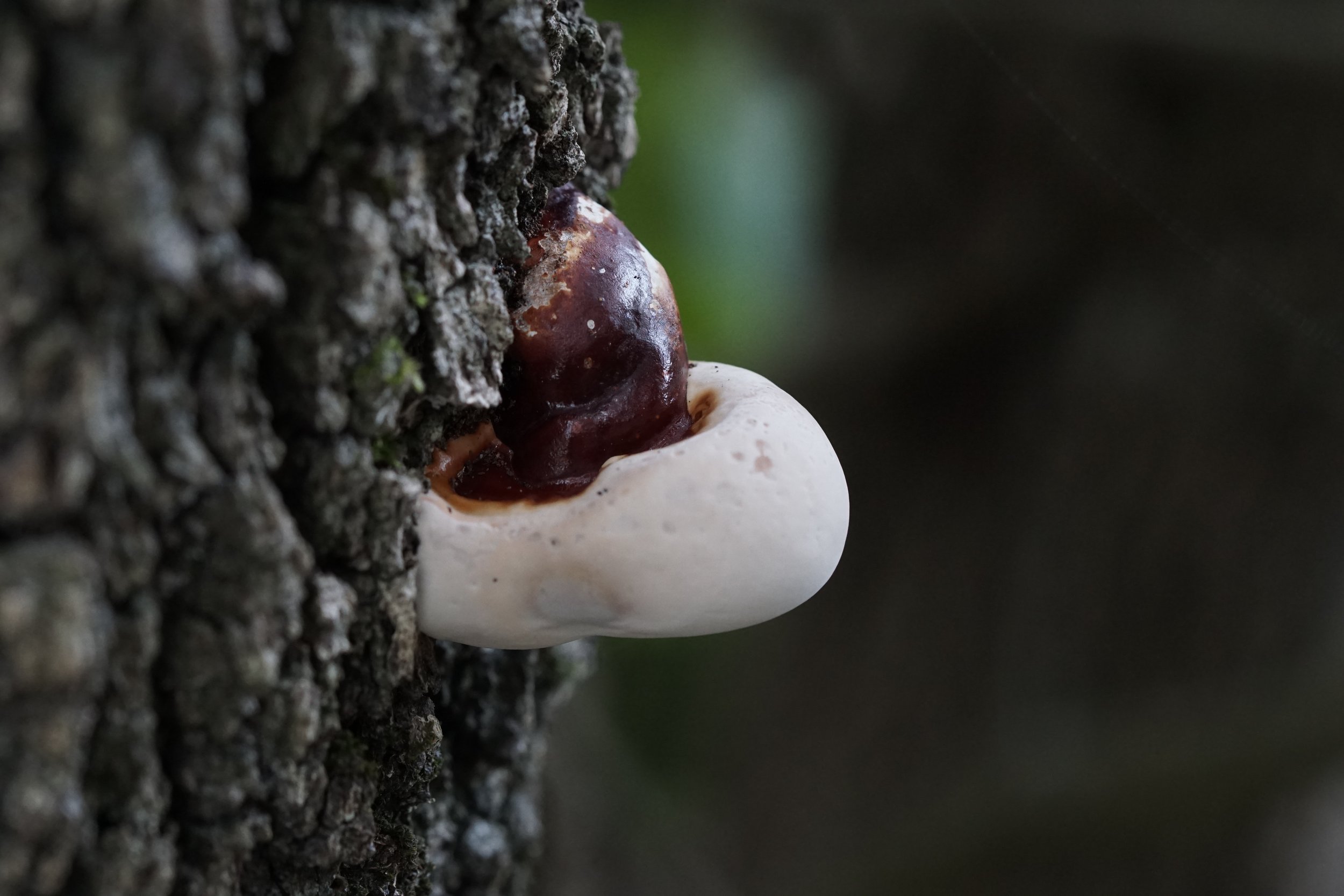Growing Mushrooms with Mycelium Dowels
If you have landed here, from scanning one our QR codes attached to our Myceliated Dowels, Welcome!
We are going to show you how to chop-drop-innoc your substrate & care for these alchemical wizards!
Important Storage Note:
store your mycelium dowels in the fridge, until you are ready to use them. This slows down the growth of mycelium, to prevent mushrooms from fruiting inside the jar!
What are Mycelium Dowels?
These are hydrated, sterilized and untreated beech-wooden dowels with a cut groove. The dowels act as a carrier for the selected fungal species, after sterilisation we introduce these dowels to the selected fungal species in a controlled laboratory environment and allow them to grow. Once fully grown they can be transferred to a log and outdoor environment and be more resilient
Inoculating logs is one of the easiest, low tech and accessible ways of growing edible and gourmet mushrooms. With a little effort, followed by time and patience, one is gifted with abundance and wonder for years to come.
How to use Mycelium Dowels
Mycelium is the root system of fungi, the vegetative underground forager that secrete enzymes and acids to break down and alchemize nutrients from organic matter into soil. These mycelium beech-wood dowels are a means of inoculating (impregnating) logs with a select strain of mushroom.
Our jars of dowels contains 300-350 dowels. This can inoculate roughly 6-10m of inoculated logs depending on diameter, at a 10cm spacing between dowels.
MATERIALS NEEDED
Drill
8.5mm drill bit
Hammer (or hardwood stick)
Double boiler – pot with water & designated bowl for beeswax
Paint brush
STEPS – BY - STEP
1. Source wood
2. Drill holes (8.5mm drill bit)
3. Hammer dowel into hole
4. Seal hole with melted beeswax
5. Place in shaded area
6. Hydrate occasionally
7. Patience
Inoculating Substrate - Drill, Hammer & Seal
Drill holes approximately 20mm deep or the depth of the dowel, use a drill bit that is the same size as the dowel, typically 8.5mm-9mm works best for a tight fit and holes should be drilled about 10cm apart around the entire diameter of the log
2. Plug your myceliated dowels into the holes & hammer them in
(ideally below bark, flush with wood surface).
3. Melt some beeswax, either using a blow torch or a double boiler method & using a small paint brush, paint the beeswax over the dowel-plugged hole to seal any gaps.
(you only need a small amount of beeswax to seal each hole)
Once all of your holes are sealed, find a partially shady spot outdoors & keep them moist!
For more in-depth info on selecting a location, caring for your logs & the alchemical process of mushrooms fruiting read our blog post here: Caring For Inoculated Logs
In this method of mushroom cultivation, it takes roughly 8-16months (depending on strain, time of year and diameter of log) for the mycelium to grow throughout log and commence fruiting mushrooms! After initial fruiting, mushrooms can continue to flush periodically depending on food, strain, weather, and time of year. They have the potential to fruit mushrooms for years to come as they slowly alchemize wood into soil.
LOG STACK · FRESH IS BEST
By inoculating fresh, healthy logs (cut within 4 week old) we give our fungi of choice the best chance of mycelium take over; The fungi become the main dominating decomposing organism present in the log and the wood is ripe with water and sugary sap for optimate fungal growth. Dead or dying logs tend to already host decomposing fungi which make them not the best for log inoculations.
Mushrooms love to grow! If you follow the above-mentioned principles on any kind of carbon-based wood source, chances are, they will grow and fruit mushrooms. Some strains are more particular about their food source then others. See mushroom strains for info on woody food source for each mushroom species.
CARING FOR YOUR MUSHROOM LOG
The more hydrated these logs are throughout the growing process, the bigger and more abundant the mushroom flushes will be. The log stacks can be watered on occasion, as one may water their garden, however, isn’t totally necessary. Location, weather, and accessibility are things to consider when creating your log stacks. A general rule of thumb for location is to store logs in a shaded area, away from drying winds.
WHERE TO PLACE YOUR LOG
Logs can become boarders to garden edges and be watered along with plants
Log stacks covered in a tarp (silver side up) in the shade to create a humid environment underneath the tarp for fungi to thrive
Forest Stack - Simply allow nature to hydrate mushroom logs during the wetter months
MYCOREGEN
The use of fungi as a land management tool to regenerate and restore the ecosystem.
Inoculate stumps instead of using harmful chemicals such as glyphosate
Inoculate directly into standing wild tobacco, devil’s fig, privet, and other invasive weeds, as a beneficial medicinal ally instead of using harmful chemicals
Ring barking and inoculating is an effective means of selectively decomposing tree species and allowing native understory to flourish
**This has been shown to work however with so many variables we cannot guarantee success.
We highly encourage experimentation and would love to hear about how it went.
SOURCING SUBSTRATE
For this example we used palm trunks that we cut down, to allow a passageway of sunlight onto a hillside of vetivers.
However we encourage you to allow your imagination to guide you.
Fungi are ever-evolving beings after all…
One of fungi’s important roles in the environment is to break down organic material produced by plants. To do this fungi have a robust tool kit of acids and enzymes they use to digest their food.
Fungi will alter its digestive juices to best digest the material.
There are a few considerations, when selecting wood to use for your chosen fungal species such as;
time of year, oil content in the wood and density of the wood.
Many cultivated gourmet/medicinal mushrooms are called “white-rotters” these fungi digest the lignin in wood which is one of natures hardest materials in nature.
A typical rule of thumb is to avoid fruit wood as they typically have high anti-fungal oil content.
That being said, we have successfully fruited Reishi on Mango wood. Fungi are the ultimate decomposers and highly adaptable so most wood sources are possible however the consequence tends to be smaller fruits and less of them.
There are not many “hard” rules with cultivating fungi, they more rough guide lines and following these guide lines should increase the chance of successful colonisation and fruiting abundance.
MUSHROOM STRAINS
We have a mixed selection of local, wild, cloned strains and cultivated favourites to choose from. Typically, it is said that fruit wood is not the most ideal for growing mushrooms due to the anti-fungal content present in the wood. However, fungi are highly adaptable and robust so we encourage you to play.
For species such as Reishi, Shiitake and Lions Mane it is best to select a “hardwood” tree.
If the tree is deciduous, it is best to cut the tree just before spring time when sap is flowing in abundance. This capture as much stored sugars as possible in the wood to then become food for your selected species.
Species such as Oyster or Turkey Tail are much more robust in our experience and can do well on a much broader variety of wood/substrates, but will also be happy on a hard wood species. The size of the wood is an important consideration. If it is very small the fungi will consume it very quickly and produce very small fruits.
If it is too big, you wont be able to move it and may struggle to sufficiently “inoculate” it.
We have found that a diameter of around 25cm and a length of around 1m is a great size for movability, with a typical colonizations time of around 6-18 months.
Once fruiting has started they can continue to fruit for years to come.
Now that you have selected the wood that you intend to inoculate and you have acquired the dowels ready to be introduced into the wood, it is time to cut the tree
(this should be done by a licensed chainsaw operator or if the material is coming from a tree that is being pruned all safety measures should be taken).
OYSTER
Oyster mushrooms (Pleurotus sp.) are a gourmet edible mushroom that are vigorous, fast growing and not picky eaters! If it’s carbon based, they’re mycelium runs happily. They are a great choice when desiring to grow a gourmet edible or to employ as a decomposer of undesirable weeds such as privot, woody tobacco, lantana, devil’s fig, camphor and so much more!
Pearl Oyster
– Pleurotus Ostreatus
A stunning blue capped beauty
Native White Oyster
– Pleurotus Ostreatus sp.
A cloned species from the forests of Mount Wanganui
SHIITAKE
Shiitake mushrooms are famous for taking culinary dishes to the next level!
Not only are they highly medicinal but they are also delicious and a wonder to grow. They grow slower than other mushroom varieties however can fruit in large abundance and for years to come. They’re preference is hardwood. Ie. Eucalyptus species, Pecan wood (they seem to adore)
Native Australian Shiitake
– Lentinula Lateritia
A cloned species from an abundant harvest of the Wilsons Creek forests.
Japanese Shiitake
– Lentinula Edodes
A well know medicinal gourmet edible strain
TURKEY TAIL
A vigorous, fast growing leather fungi that fruits in abundance. This species is known for her immune enhancing, cancer fighting and prebiotic properties. She is an ally to all of nature’s creatures. Similar too the oyster mushroom, turkey tail is not picky when it comes to their carbon food source. She too is a great regen companion, growing especially well on camphor laurel species.
Turkey Tail
– Trametes Versicolor
a cloned species from Bundjalung country,
the Bryon bay hinterland, NSW
Turkey tail -Trametes Versicolor - growing on Camphor laurel and expressing colour variations.
GANODERMA
REISHI”S CLOSE RELATIVE
Ganoderma species are hard woody bracket fungi, a potent perennial medicinal mushroom. They have demonstrated to have great medicinal value for Bee’s. The Bee’s can be seen suckling on the digestive enzymes and acids, which brings health to the whole hive. Overall Ganoderma species have great medicinal effort for the ecosystem. They’re preference is hardwood but have also been seen to grow on a wide variety of tree species.
‘Reishi’
- Ganoderma Styaertanum
a cloned species from Brunswick Heads, NSW
Ganoderma Resinaceum
a cloned species, found in the Boarder Rangers National Park. He fruits commence from large white orbs and blossom into large purple tinted shiny mushrooms.




















